Marine Scotland Science Report 01/15: Status of Scottish Salmon and Sea Trout Stocks 2014
Report assessing the status of Scottish salmon and sea trout stocks in 2014, based on the annual salmon and sea trout catch statistics.
Annual Counts
The annual upstream counts at Logie generally increased from the early 1980s. Recent years were largely characterised by high numbers of returning adults and, although numbers dropped sharply in 2012 and 2013, counts rose slightly in 2014 to median levels (Figure 5). The Westwater counts revealed no evidence of a long-term trend in salmon numbers. However, sharp declines in net upstream counts in 2012 and 2013 mirrored those at the Logie counter, as does the slight rise in 2014. Upstream counts on the Helmsdale show no clear trend over the relatively limited period of operation from 2001 onwards. Unlike the recent data from the North Esk, Helmsdale counts rose in 2013 followed by a sharp fall in 2014.
Figure 5: Annual net upstream counts of adult salmon at MSS counter sites
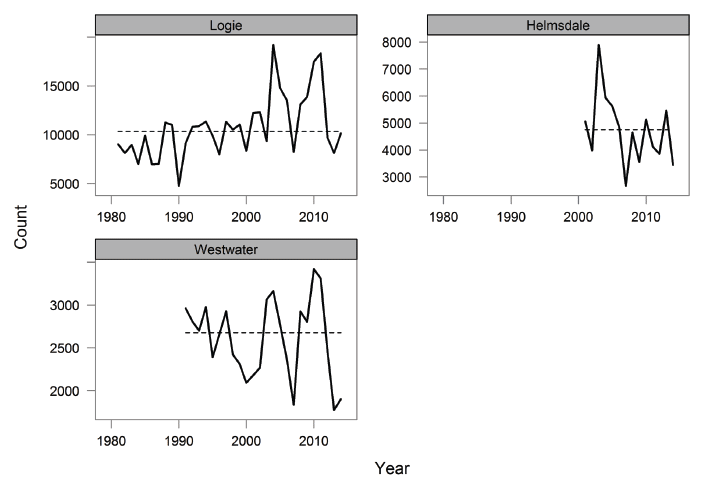
Spring
Counts generally increased at Logie peaking in 2011 (Figure 6) before dropping to around the long-term median in the three subsequent years. There were no clear trends in the counts at Westwater or Helmsdale (Figure 6).
Figure 6: Net upstream counts of adult salmon at MSS counter sites during spring months.
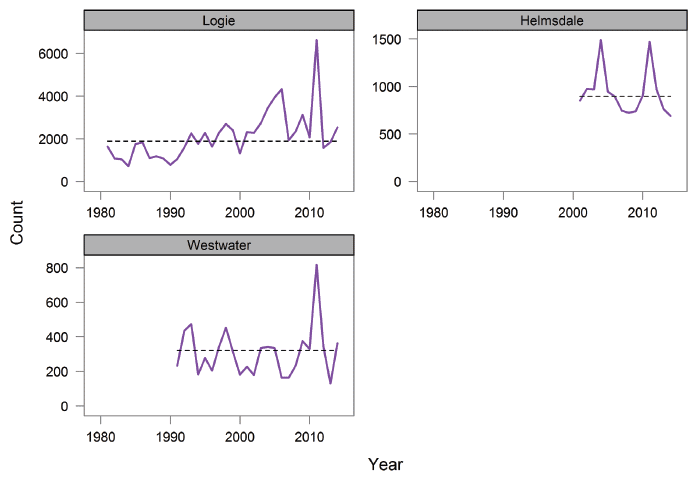
Summer
Summer counts at Logie trended upwards to a peak in 2010 (Figure 7) before dropping to around the long-term median in the last two years. There was no evidence of trends in the shorter term counts at the Westwater or Helmsdale (Figure 7).
Figure 7: Net upstream counts of adult salmon at MSS counter sites during summer months.
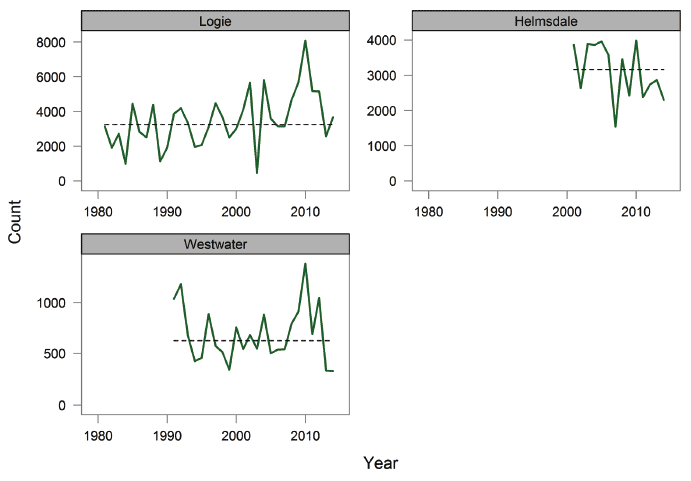
Autumn
In comparison to the spring and summer periods there were no clear long-term trends in the numbers of salmon passing any of the counters during autumn months (Figure 8). Counts in 2014 were close to the long term median for each of the sites.
Figure 8: Net upstream counts of adult salmon at MSS counter sites during autumn months (including November).
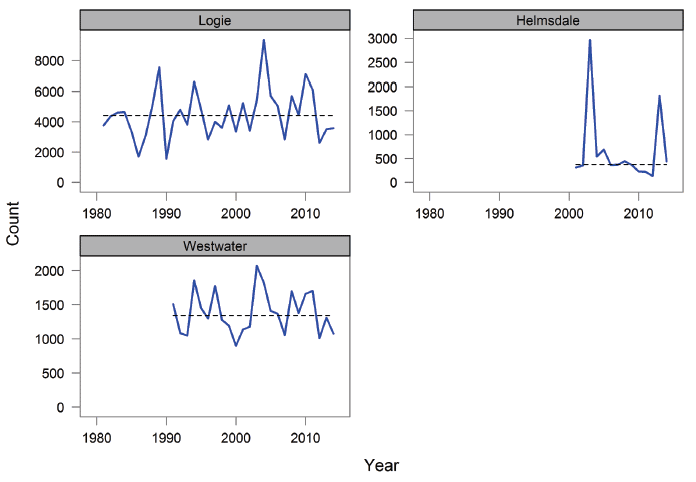
Traps
As with counters, fixed traps are a direct method of assessing numbers of returning adults and are not subject to uncertainties associated with rod catches. Marine Scotland Science operates traps on two upper tributaries of the Aberdeenshire Dee (the Girnock and Baddoch burns). These tributaries are dominated by early-running spring salmon (multi-sea winter fish), the stock component that has been of greatest concern in recent decades (see the section on spring catches). Although there are similar temporal trends in numbers of male and female salmon caught at the traps, only female numbers are plotted here, as availability of eggs is generally the limiting factor in the reproductive potential of the population.
Figure 9: Numbers of adult females returning to the Girnock and Baddoch traps. The solid blue horizontal line represents the estimated stock level required to maximise production of emigrants (Smax) for each site, with the horizontal blue dashed lines indicating the error around these estimates (95% C.L.s). In the case of the Girnock Burn, estimates of Smax also reflect between year competition among salmon parr not considered for the Baddoch.
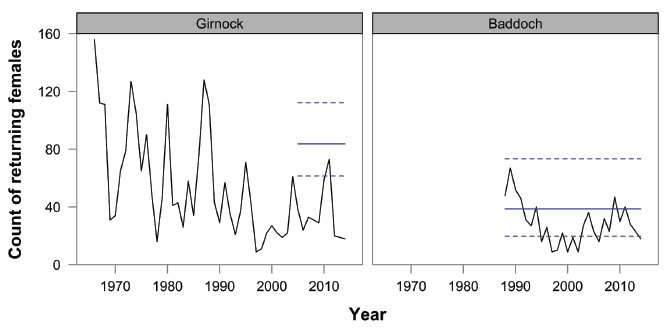
The number of female salmon that returned to the Girnock and Baddoch traps varied substantially among years over recent decades. However, there was an overall declining trend in female spawners up until 1997, after which numbers have stabilised or slightly increased. The 17 female salmon caught in the Girnock trap and 18 females caught in the Baddoch trap in 2014, are 32% and 62% of the long-term mean values respectively (Figure 9).
The Deeside traps allow counts and collection of associated biological data on ages and sizes of both returning adult and juvenile emigrant salmon. Using this information it is possible to establish the number of returning fish required to maintain maximum production of emigrants (Smax). For recent years it is estimated that 84 (95% Confidence Limits: 62-112) and 39 (95% C.L: 20-70) females would be required to maximise production of emigrants from the Girnock (Bacon et al., in press) and Baddoch respectively. Although both sites fell short of these levels in 2013 and 2014, the number of females returning to the Baddoch was within the confidence intervals of Smax in 2013 and, therefore, maximum emigrant production may have been maintained in this year (Figure 9). In the case of the Girnock, returning female numbers were outside of the confidence limits for Smax (adjusted for between-year competition) and it can, therefore, be concluded that resulting emigrant production will probably be below maximum levels for both 2013 and 2014 spawning years. While emigrant production will be lower than possible for these spawning years, this does not necessarily mean that the stocks will also be below conservation limits. Conservation limits can be defined in a number of different ways (e.g. maximum sustainable yield, Smax) and work is ongoing to define conservation limits for Scottish rivers.
Survival Rates
Given an estimate of emigrant production and the numbers and ages of returning adults it is possible to estimate the rates of return of emigrants to various stages in their life cycle. Depending on where the data were collected on the river system these return rates can provide estimates of marine survival (% return to the coast), the combined effects of marine survival, coastal and in-river net fisheries (% return to the river) or the combined effects of marine survival, coastal and in-river net fisheries and angling (% return to spawn). Data collected on the North Esk allows estimates of all three of these return rates to be calculated at the scale of a whole river catchment (Figure 10). Data from the Girnock and Baddoch traps provide an estimate of % return to spawn for two sub-catchments dominated by spring fish (Figure 11).
Figure 10: Percentage of North Esk juvenile emigrants (smolts) that return to the coast, to the river and to spawn. Emigrant numbers were estimated at Kinnaber Mill lade. Adult numbers were estimated using data from the Logie fish counter and information from local fisheries. The ages of returning fish were estimated from a sample of fish taken in the net and coble fishery.
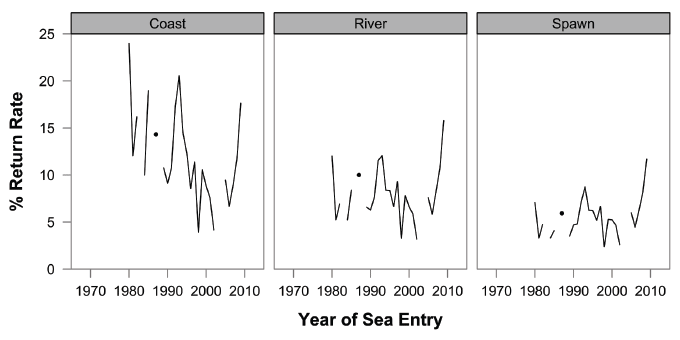
Figure 11: Percentage of juvenile emigrants (autumn parr and smolts) that return to the Girnock and Baddoch traps to spawn as adult females. Emigrant and female spawner numbers were obtained from direct counts at the traps. Ages of female fish were obtained from scale reading.
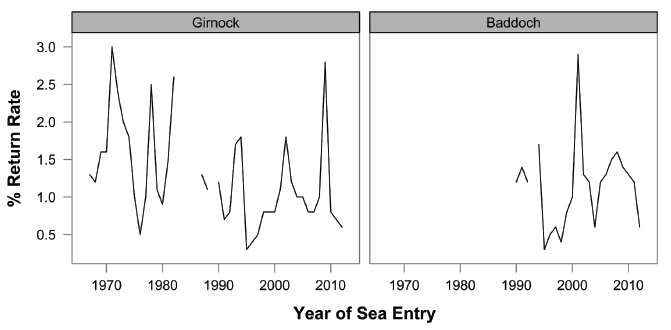
The return rates to the Coast for the North Esk are based on smolt estimates obtained at Kinnaber lade, and an estimate of adult numbers obtained from the Logie counter and the fisheries. There has been an overall downward trend in the return rate to the coast between the late 1970's and late 1990's and an increasing trend between 2006 and 2009 (Figure 10). Unfortunately, it was not possible to obtain reliable estimates of smolt numbers in all years and there has been no smolt count since 2009. Differences in the temporal trends shown by returns to the coast and those to the river or to spawn reflect the additional influence of fisheries. Consequently all three return rates become increasingly similar over time because of the decline in fishing mortality.
Return rates for the Girnock and Baddoch traps were calculated from a count of emigrants (autumn parr and smolts) leaving the catchment and adult female spawners returning to the traps. Temporal trends in return rates were broadly similar to those for adult returns at the Girnock and for return rates to the coast in the case of the North Esk. There was an overall downward trend between the 1970's and mid-1990's, followed by a small increase or stable conditions thereafter.
Interpretation
A number of indicators can be used to assess stock status. These indicators have different strengths and weaknesses. Rod catch data provide broad geographic coverage and a long-term perspective on numbers of returning adult salmon, but not a direct measure of abundance nor the level at which returning numbers affect freshwater production of emigrants. Counters provide a catch-independent method of assessing adult returns where suitable quality control and validation occur and, potentially a direct measure of abundance of returning adults. However, counters do not currently provide broad spatial coverage and cannot be used on their own to derive spawning targets, since this process requires additional biological data. Fixed traps are also a useful catch-independent measure of numbers of returning adult salmon. In some circumstances trap data can be used to place returner numbers in the context of those required to maintain freshwater salmon production at a particular level. However, fixed traps are expensive to operate and thus cannot provide the large scale geographic coverage required for a comprehensive assessment of stock status across Scotland. Because of these particular strengths and weakness, an overall assessment using all data sources is stronger than any individual indicator.
Viewed in terms of a long-term trend over several decades, the numbers of adult salmon returning to Scottish rivers have increased. This patterns reflects a decline in marine survival being offset by reductions in the netting industry allowing a greater proportion of fish to enter rivers and hence increased rod fisheries. Given the increase in catch and release by the rod fisheries this has also led to greater spawner escapement. More recently, the sharp decline in reported catches is a cause for concern, although catch independent data suggest that particularly low catches in 2014 may have also been influenced by poor angling conditions leading to relatively low exploitation rates. Within this overall pattern, there are some clear variations in terms of stocks and regions, as follows:
Spring Stocks
- Total catches of spring salmon have declined over the long-term, but stabilised in recent decades. The observation of a long-term decline in spring stocks, suggested by trends in rod catch, is paralleled by local catch independent data from fixed traps on Deeside. These data show that although adult returns have stabilised in recent years, they are on occasion, still below the level required to maintain maximum production of emigrants. The wider applicability of these findings for spring fish tributaries elsewhere in Scotland is currently unknown. Contrary to spring catches on the North Esk, the Logie counter data show an increasing trend in recent decades and more recently a return to the median value. This observation may reflect local variation in trends in spring salmon numbers and potentially changes in exploitation rate over time. Evaluation of changes in exploitation rate is the subject of on-going detailed analysis.
Summer Stocks
- The decline in salmon numbers identified by the Logie counter in 2013 and 2014 is similar to that in rod catches, but less extreme. This would be consistent with a combination of weaker returns of salmon in recent years and lower rates of exploitation. A similar decline was evident on the Helmsdale counter but was less obvious on the Westwater where, given its tributary location, seasonal distinctions are likely to be blurred. Although a decline in catches of summer fish was not geographically uniform, there was a sharp increase in the numbers of regions in which the rod catch tool indicated statistically significant declines in catches over previous years.
Autumn Stocks
- Following a long-term increasing trend in autumn catches there was a steep decline in 2014 that generated considerable spatial variation in the results of the rod catch tool. This recent trend in catches contrasts with counter data, which have been relatively more stable. The rod catch tool indicates a growing number of regions in which there is a significant downward trend in catches particularly on the east coast and south west.
Sea Trout
Rod Catches
As with salmon, rod catches have traditionally been used to assess the status of sea trout in Scotland. Thus in the absence of fish count or trap data the following assessments are based on rod catch alone. Further, as we have no information on structured run-timing in sea trout stocks, analyses are based on annual catches. The rod catch tool has been applied to the last 20 years of sea trout catches to determine recent trends.
The number of sea trout reported to have been caught by rod fisheries across Scotland has decreased markedly over the entire data period 1952-2014 and over the most recent 20-year period (Figure 12).
Figure 12: Annual reported catches of sea trout by rod-and-line fisheries in Scotland 1952-2014. The line indicates the total reported catch (retained and released) and the shaded area the catch corrected for the effect of catch and release
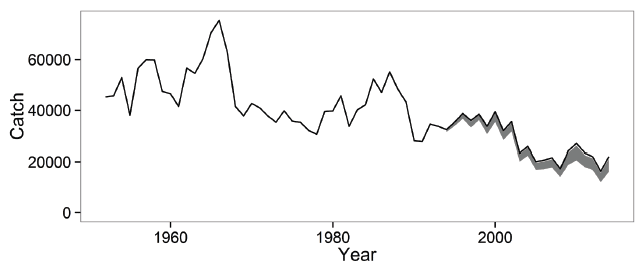
Spatial Variability in Rod and Line Catches
Of the 85 districts where reported catches allowed for use of the rod catch tool, there is evidence of recent declines in 37 of the districts, no evidence of a change in 35, and evidence of recent increases in 13 (Figure 13).
Figure 13: Trends in the reported catches of sea trout 1952-2014 by statistical district.
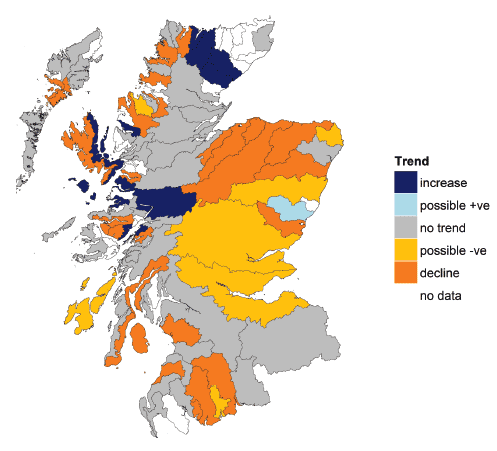
Return Rates of Sea Trout
A two-way fish trap has been operated on the River Shieldaig since 1999. This system allows the capture of sea trout as they migrate to sea and as they return to the river. Individually marking the fish (using VI tags in 1999 and PIT tags since 2000) enables calculation of the proportion of tagged emigrants that subsequently return to the river, providing an index of marine conditions.
Due to the small number of wild fish migrating from the system and the requirement for larger numbers to provide a more accurate measure of return rates, the Shieldaig system has been stocked since 1998. From 1997 to 2005 non-native trout were stocked into the river as fry and were identifiable by the presence of a clipped adipose fin (Hay & Hatton-Ellis 2006). During 2006-2008 stocking of eggs from a mix of native and non-native fish was undertaken, with eggs from known native origin fish being stocked from 2009 onwards. The return rates are, therefore, presented as two separate time series, one for clipped fish, which originated from fry stocking, and one for unclipped fish, which originated from natural spawning and stocked eggs.
Figure 14: The proportion of marked sea trout of different origins returning to the River Shieldaig in relation to fish farm production cycles. Data for clipped fish span 1999-2009, unclipped 1999-2013.
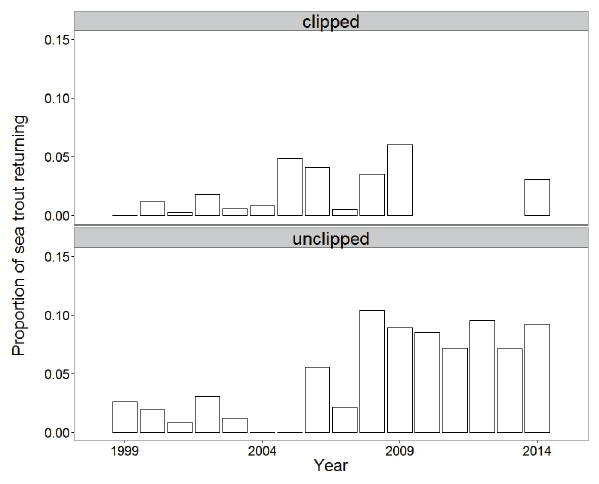
The overall pattern shown by the data suggests an increase in return rates of sea trout at the Shieldaig site since the early 2000s, appearing to stabilise at a new, higher, level in recent years.
Interpretation
In assessing the status of sea trout stocks from rod catches it is important to acknowledge that such data provide broad geographic coverage and a long-term perspective on numbers of returning adult sea trout, but not a direct measure of abundance, nor the level at which returning numbers affect freshwater production of sea trout smolts. While catches provide a good indicator of the success of the fishery their use in assessing stock status is hindered by the absence of any direct measures of abundance from, for example, traps and counters. In addition, trout have a complex life cycle with both migratory (sea trout) and non-migratory (brown trout) forms existing and potential plasticity in life history strategies. The dynamics of stocks that include both brown and sea trout is poorly understood and, therefore, the relationship between sea trout catch data and stock levels is uncertain.
With these provisos in mind, the picture is one of historically low levels of adult returns to rivers across the whole of Scotland. While many areas of Scotland are at historically low levels, the rod catch tool has highlighted additional notable declines in catches in recent years in the central-eastern, south west and north west areas of the country.
Contact
There is a problem
Thanks for your feedback